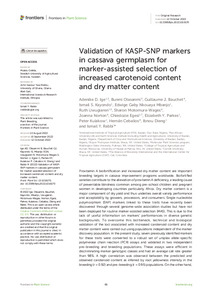| dc.contributor.author | Ige, A.D. |
| dc.contributor.author | Olasanmi, B. |
| dc.contributor.author | Bauchet, G.J. |
| dc.contributor.author | Kayondo, S.I. |
| dc.contributor.author | Mbanjo, E. |
| dc.contributor.author | Uwugiaren, R. |
| dc.contributor.author | Motomura-Wages, S. |
| dc.contributor.author | Norton, J. |
| dc.contributor.author | Egesi, C. |
| dc.contributor.author | Parkes, E. |
| dc.contributor.author | Kulakow, P. |
| dc.contributor.author | Ceballos, H. |
| dc.contributor.author | Dieng, I. |
| dc.contributor.author | Rabbi, I.Y. |
| dc.date.accessioned | 2022-12-14T07:18:59Z |
| dc.date.available | 2022-12-14T07:18:59Z |
| dc.date.issued | 2022 |
| dc.identifier.citation | Ige, A.D., Olasanmi, B., Bauchet, G.J., Kayondo, S.I., Mbanjo, E., Uwugiaren, R., ... & Rabbi, I.Y. (2022). Validation of KASP-SNP markers in cassava germplasm for marker-assisted selection of increased carotenoid content and dry matter content. Frontiers in Plant Science, 13 : 1016170,1-17. |
| dc.identifier.issn | 1664-462X |
| dc.identifier.uri | https://hdl.handle.net/20.500.12478/7973 |
| dc.description.abstract | Provitamin A biofortification and increased dry matter content are important breeding targets in cassava improvement programs worldwide. Biofortified varieties contribute to the alleviation of provitamin A deficiency, a leading cause of preventable blindness common among pre-school children and pregnant women in developing countries particularly Africa. Dry matter content is a major component of dry yield and thus underlies overall variety performance and acceptability by growers, processors, and consumers. Single nucleotide polymorphism (SNP) markers linked to these traits have recently been discovered through several genome-wide association studies but have not been deployed for routine marker-assisted selection (MAS). This is due to the lack of useful information on markers’ performances in diverse genetic backgrounds. To overcome this bottleneck, technical and biological validation of the loci associated with increased carotenoid content and dry matter content were carried out using populations independent of the marker discovery population. In the present study, seven previously identified markers for these traits were converted to a robust set of uniplex allele-specific polymerase chain reaction (PCR) assays and validated in two independent pre-breeding and breeding populations. These assays were efficient in discriminating marker genotypic classes and had an average call rate greater than 98%. A high correlation was observed between the predicted and observed carotenoid content as inferred by root yellowness intensity in the breeding (r = 0.92) and pre-breeding (r = 0.95) populations. On the other hand, dry matter content-markers had moderately low predictive accuracy in both populations (r< 0.40) due to the more quantitative nature of the trait. This work confirmed the markers’ effectiveness in multiple backgrounds, therefore, further strengthening their value in cassava biofortification to ensure nutritional security as well as dry matter content productivity. Our study provides a framework to guide future marker validation, thus leading to the more routine use of markers in MAS in cassava improvement programs. |
| dc.description.sponsorship | UKs Foreign, Commonwealth & Development Office |
| dc.description.sponsorship | Bill & Melinda Gates Foundation |
| dc.format.extent | 1-17 |
| dc.language.iso | en |
| dc.subject | Cassava |
| dc.subject | Manihot Esculenta |
| dc.subject | Provitamins |
| dc.subject | Dry Matter Content |
| dc.subject | Marker-Assisted Selection |
| dc.title | Validation of KASP-SNP markers in cassava germplasm for marker-assisted selection of increased carotenoid content and dry matter content |
| dc.type | Journal Article |
| cg.contributor.crp | Roots, Tubers and Bananas |
| cg.contributor.affiliation | International Institute of Tropical Agriculture |
| cg.contributor.affiliation | University of Ibadan |
| cg.contributor.affiliation | Boyce Thompson Institute |
| cg.contributor.affiliation | Washington State University |
| cg.contributor.affiliation | University of Hawaii at Manoa |
| cg.contributor.affiliation | Cornell University |
| cg.contributor.affiliation | Alliance of Bioversity International and CIAT |
| cg.coverage.region | Africa |
| cg.coverage.region | West Africa |
| cg.coverage.country | Nigeria |
| cg.coverage.hub | Headquarters and Western Africa Hub |
| cg.researchtheme | Biotech and Plant Breeding |
| cg.identifier.bibtexciteid | IGE:2022 |
| cg.isijournal | ISI Journal |
| cg.authorship.types | CGIAR and developing country institute |
| cg.iitasubject | Agronomy |
| cg.iitasubject | Cassava |
| cg.iitasubject | Food Security |
| cg.iitasubject | Plant Breeding |
| cg.iitasubject | Plant Production |
| cg.journal | Frontiers in Plant Science |
| cg.notes | Open Access Article; Published online: 12 Oct 2022 |
| cg.accessibilitystatus | Open Access |
| cg.reviewstatus | Peer Review |
| cg.usagerightslicense | Creative Commons Attribution 4.0 (CC BY 0.0) |
| cg.targetaudience | Scientists |
| cg.identifier.doi | https://dx.doi.org/10.3389/fpls.2022.1016170 |
| cg.iitaauthor.identifier | Kayondo Siraj Ismail: 0000-0002-3212-5727 |
| cg.iitaauthor.identifier | Edwige Gaby Nkouaya Mbanjo: 0000-0002-9982-1137 |
| cg.iitaauthor.identifier | Chiedozie Egesi: 0000-0002-9063-2727 |
| cg.iitaauthor.identifier | E J Parkes: 0000-0003-4063-1483 |
| cg.iitaauthor.identifier | Peter Kulakow: 0000-0002-7574-2645 |
| cg.iitaauthor.identifier | Ismail Rabbi: 0000-0001-9966-2941 |
| cg.futureupdate.required | No |
| cg.identifier.volume | 13 |

